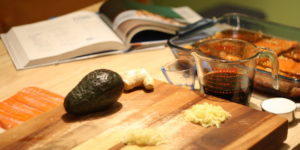I can sometimes spend more time cruising through a good cookbook than actually cooking; especially if it has good pictures, so I was excited to get my copy of “Everyday Secret Restaurant Recipes” by Leah Schapira & Victoria Dwek. It focuses on a collection of family-friendly, quick and easy meals from “your favorite kosher cafes, takeouts & restaurants”.
As I ventured into the book, there were several recipes that caught my eye, but the one I decided to make first was “Dynamite Salmon” from a place called Fresko in Aventura, FL. This recipe is a sushi-influenced dish with shredded kani (fake crab) and avocado, but everything is cooked; no raw fish here. It seemed like a good candidate to try because my family does like sushi and usually everyone gobbles up salmon.
Normally I don’t follow recipes exactly. I have been known to look at the picture in a cookbook and wing it from there. However, since I was doing this as a review of the book, I made sure to measure out the ingredients and stick to the recipe…mostly. I started with the salmon and added the sesame oil and soy sauce to the baking dish. It looked like too much liquid to me, but I fearlessly pressed on and preheated the oven while the salmon marinated. Next, I made the teriyaki sauce, which came together with no worries at all. I have to admit, I did like this sauce and may tweak it just a little for some of my own dishes in the future.
The next step is where I ran into trouble and had to deviate from the book. The recipe calls for ½ cup of mayonnaise for 2 ounces of kani, but as I started adding mayo I could tell that was going to be WAY too much. There is no way that is the right amount, and judging by the picture in the book, they didn’t put nearly that much in theirs either. In the end, I had less than ¼ the amount of mayo the recipe called for as written, and that seemed about right.
My wife and I thought this dish was fairly tasty, but the kids were not so impressed. My son did not want to touch the avocado, but we learned that my daughter is a fan of the green stuff. I think I may make this again sometime, but I will make a few changes to the recipe. For example, I will not put quite as much soy sauce in when it bakes, and I may serve it over sushi rice instead of the kani and mayo dynamite mixture.
I tried another recipe from the book, dessert this time, and had a similar experience; it didn’t seem quite right as it was written, but with a little modification it came out pretty good. This recipe was for “Crème Brulee Freezer”, which is basically a milkshake with coffee and caramel…yeah, you read that right, now stop drooling. The first one I made had enough coffee in it that it was more like a thick caramel latte (maybe my ice cream scoop is smaller than theirs), but when I used a little less coffee and a little more ice cream I got a nice thick shake. In the future, I have my eye on a couple other recipes that I plan to try. I’m looking forward to the “Mushroom Noodles” (I like fungus) and the “Pulled Brisket Panini”, but I will definitely tweak those recipes as I go along.
I would say this was an okay cookbook; not the best, but not bad either. On the plus side, the book does have some tasty looking food that I definitely would like to try cooking at home, or at the very least use as inspiration for my own recipe ideas. Plus, there are lots of little tips sprinkled throughout the book to help a home cook get these restaurant recipes to come out right. On the other hand, I felt that the recipes were more of a starting point, and I really need to use my own judgement when putting them together.
With regard to the book itself, I wish it had more than just the one picture for each dish (sometimes I like to see the steps in the process), or pictures of the restaurants where the recipes came from. For example, one page talked about how the interior of the restaurant was designed and built by the owners, and I would have loved to see what it looks like.
If you are looking to cook something inspired by what’s on the menu at some Kosher restaurants from around the world, this may be a fun cookbook for you. However, you will need to be comfortable coloring (or cooking) outside the lines and modifying the recipes as you go along. Most of the recipes are relatively simple, so that shouldn’t be too much of a challenge if you know your way around the kitchen. As for me, while this may not end up being one of the most used cookbooks in my kitchen, it is a nice book with a few good ideas that will look great up on the shelf.




